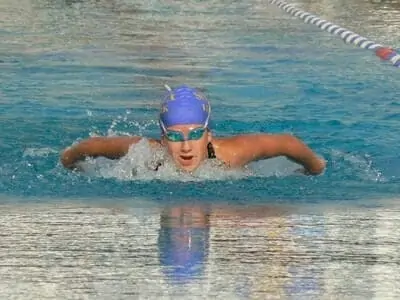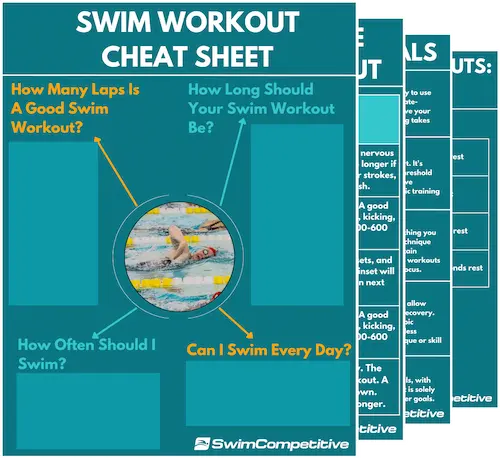Butterfly races are usually some of the most dreaded events among competitive swimmers. That, however, shouldn’t be the case, and is why in this article we’ll be taking a look at how to swim the 100 fly so that you can step up onto the starting blocks feeling confident and ready to swim fast.
We’ll cover everything from basic technique, a comprehensive race strategy, as well as common mistakes and some killer training sets used by some of the best butterfly swimmers around the world so that by the end of this article, you’ll be as prepared as you can be to go and master the 100 butterfly event.
For those of you who already have the butterfly technique down, you still might want to consider reading the technique portion of the article. I highlight a lot of little details and things that are easy to forget that can have a big impact on your stroke and speed in the water.
Getting Started: Master Basic Butterfly Technique First
1. Body Position
No matter what the stroke, the first thing you always want to make sure that you understand is the body position in the water. Your body position is like the foundation of your stroke- if it’s bad the rest of your stroke is bad as well no matter what you do, and if it’s good then you’ve set a good base to start working from.
With butterfly, the body position is a bit different than other strokes such as freestyle, backstroke, and even breaststroke since a lot of undulation is involved while swimming, meaning that your body will frequently change position as you move through the water.
That said, there still is a definite body position that you should aim to maintain as you swim to maximize your speed and efficiency in the water.
In a good butterfly body position, your hips will sit high in the water, in some cases just above the surface, with the upper body angling slightly down, your arms will be next to or just behind the ears while your head will be in a neutral position looking straight down at the bottom of the pool. Your chest should also be pushed out. This is the ideal body position you should be maintaining for the majority of your stroke.
As mentioned, undulation is an important part of the stroke, meaning that this position does vary. Some points to note here include-
- When your head is under the water, your hips will rise and become the highest part of your stroke.
- When your head is above the surface, your hips will drop slightly.
A popular drill coaches like to use is to place 4 kickboards under the swimmer’s hips, 1 under the chest, and then 2 or 3 under their palms while they are lying down on the pool deck. This should give you a pretty good idea of what good butterfly body position will look like.
Here’s a quick visual explanation-
2. The Kick
The kick is one of the most important aspects of a good butterfly as it sets the tempo for your entire stroke, but more about this later. For now, let’s have a look at the technique.
In butterfly swimming, you are allowed to use as many kicks as you want for each arm cycle. However, the most optimal is going to be 2 kicks per pull and this is the kicking pattern used by all great butterfly swimmers.
The butterfly kick is a dolphin-like motion and ties in very much with the undulation of the body position that we just discussed to create a whipping movement that will shoot your upper body out of the water as well as propelling you forward in the water.
The first kick will be executed as your arms enter the water after the recovery phase of your stroke while the second will be executed alongside the pulling phase of your stroke, the second kick will shoot your hands out over the water and then back to the entry where your first kick will then be executed again.
The technique of the kick itself is very simple, just make sure to use your hips as you swim to generate maximal momentum to propel you forward as you swim.
A simple drill you can do is to do some butterfly kicking using a kickboard. You can start by pushing off the wall, then push down with your hips, allowing your thighs to follow. There should be a bend at the knee as your legs drop to the lowest position with the bend increasing the lower your legs drop.
Then straighten out your legs pointing your toes so that your body moves into a straight line as you start to bring your hips up again. This will create a whipping movement that will propel you forward in the water.
Key points–
- The kick starts with a drop in the hips.
- There should be a bend in the knees as your thighs move down. The bend increases as your legs drop.
- Your legs should be completely straightened out as you complete your kick.
- Toes stay pointed.
3. Arm Mechanics
I am quickly going to explain all three phases of the butterfly arm stroke to you. Keep in mind, these take practice to master, and simply reading this article alone isn’t enough. You’ll have to go and practice everything we’ve discussed here.
The Catch: This is the first portion of your arm stroke, and one of the most important phases. During the catch phase, you’ll be setting your grip in the water which will then help you create propulsion.
The catch phase starts with your hands entering the water. Everyone has a different entry position. Personally, I prefer a wider entry in the water, but some swimmers may prefer a narrower entry. Regardless, your entry should always be at least just outside shoulder width.
After that, your hands will go under the water where you’ll push them slightly out and then directly down so that your fingertips face the bottom of the pool. This motion should be coupled with a chest press helping you to bring your hips up and slightly tilting your upper body down.
This is the first phase of the arm stroke and it’s also paired with your first kick. (The kick is executed right as the hands enter the water).
The Pull: The next phase of the arm stroke is going to generate forward propulsion in the water. During this phase, you would’ve already gripped the water. All you need to do now is to push the water backward to create forward propulsion. This phase is coupled with your second kick which will help to shoot your arms backward and out of the water into the recovery phase.
The Recovery: This is the final phase of the butterfly stroke. During this phase, your arms will be outside of the water. The key to this phase is to stay relaxed. You should allow the momentum to carry your arms over the water, you shouldn’t actually be using any energy or effort to carry them back to the starting position where the catching phase will then start again.
Related: Butterfly Arm Stroke Technique.
4. Breathing Head Position
I know we already briefly discussed this during the body position portion of the article but I quickly wanted to cover this again in more detail, as the head position can have a big influence on your butterfly stroke.
When swimming, you should aim to maintain a neutral head position. Your head should be looking straight down at the bottom of the pool while your face is underwater. As your upper body lifts your head is naturally going to lift with it.
You should aim to keep your head as still as possible throughout your stroke.
Once your head is outside of the water you want your chin to skim across the water, you don’t want to be lifting your head too high as this will cause your hips to drop and will break your body position which will create a lot of resistance in the water.
When breathing you can choose to keep your head faced down directly at the pool and then to take a quick breath. Or you can move your head so that it is angled at about 45° before dipping down under the water again.
You, however, never want to be looking directly in front of you. As my coach always told me, you never want to be able to see the other side of the pool when taking a beath on butterfly.
Drills are a good way to work on improving your butterfly technique, consider reading my article on these top butterfly drills to improve your technique and swim faster.
Related: Butterfly breathing technique.
The 100 Fly Race Strategy: 10 Elements to a Fast Swim

Now that we’ve covered the butterfly technique and you understand all of the technical aspects to work on for a good stroke, let’s take a look at our race strategy for tackling this beast of an event.
This 100 fly race strategy is geared mostly towards the 100 meter butterfly but can still be applied to the 100 yard fly. Nevertheless, whichever race you are swimming, there are a lot of important points here to focus on for a fast and successful 100 fly.
1. The Start
Every race begins with the start of the blocks. In a way, this is easily one of the most important parts of your race since it’s going to set the mood for your entire race. If it’s bad and half-hearted your race will be too, and if it’s explosive and quick, your stroke will follow.
In the modern age of swimming, there are many variations of the start and each swimmer does it his or her own way and that’s fine. There are, however, some key elements that all good starts have in common and you should aim to work on them.
When performing a start from the blocks, always aim to involve your arms. The arms can generate a lot of extra power and force that will help to drive your forward and into the air.
Additionally, you should aim to always make the arms the first part of your body to move coming off the blocks. A common mistake swimmers make is to begin the start by moving their head, (through looking up or throwing it up or something similar) your head isn’t going to contribute to getting off the blocks as fast as possible, but other body parts like your arms and legs will.
Another important aspect to focus on is the concept of power. Sure, getting some nice distance off the blocks or having a quick reaction time is always nice but this shouldn’t be your main focus. You should rather focus on getting as much power off the block as you can to propel your body into the water which will automatically set up some speed right from the get-go.
I’d rather have you sacrifice distance or reaction time if it means you can get more power off the blocks. Some of the best starters in the world aren’t necessarily always the ones to get the furthest off the blocks, but those who generate the most power by utilizing all their muscles. Take Caeleb Dressel for example.
The last aspect of the start that I want you to pay attention to is to have a clean entry in the water. You should aim to minimize your splash going into the water since a bigger splash usually means that more surface area of your body is hitting the water and this creates unnecessary drag.
A nice drill you can use is to do starts into a hula hoop while one of your teammates holds it a certain distance from the blocks to teach yourself the concept of a clean and low profile entry into the water.
Key Points-
- Your start should be explosive and powerful.
- Use your arms to generate power off the blocks.
- Have a clean entry with minimal splash.
2. Underwaters
As soon as you’ve broken the surface of the water and your entire body has become submerged we can move onto the second phase of the 100 fly race strategy, namely the underwater dolphin kick. This phase can have quite a significant impact on your race.
For the underwater dolphin kick you have to find what works for you in generating the maximal amount of speed. There are 2 main variations of the underwater dolphin kick, which we’ll discuss in just a second.
What’s important to remember here is the fact that you really want to involve your core muscles and you want your body to move from the stomach and hips, not from your knees as this significantly diminishes your speed.
Undulation: Some swimmers have a very wavy underwater dolphin kick. This means that your kick starts way up in the upper body with a chest press which will then create a curve in your back and create a whipping effect traveling down to your toes. If this is what creates the most speed for you, go for it!
Less Undulation: The second style of underwater dolphin kick involves the kick starting in your core area. In this variation the back doesn’t move so much and the whipping effect starts in the stomach area traveling down to the toes.
Once you have the technique down, you need to practice your underwaters. And you need to practice them a lot. Set goals like doing 3 dolphin kicks off every wall in practice or have certain days where you place a lot of emphasis on doing them.
Ideally, you should also know how many kicks you want to do coming off the start and turn in your 100 fly. You may want to do 6 kicks coming off the start and 3 coming off the turn. Find what works for you. You can always change it up to make it more or less as you experiment with what’s the fastest for you.
Just remember, the underwater dolphin kick can generate a ton of speed and utilizing it to your advantage can help you to swim significantly faster. Also, if you are swimming the 100 yard fly you may want to use a slightly longer underwater, as the yard races are generally mostly swum underwater.
3. The Breakout
Once you’ve completed your underwater dolphin kicks you should be nearing the surface of the water getting ready to start the third phase of your 100 fly, namely the breakout. There isn’t too much to the breakout, but it is an important part of the race to get down.
If you break out too late you’ll waste time, ultimately slowing yourself down and if you break out too early you can create a significant amount of drag that can completely break your speed.
You want to perform the breakout as explosive as you can on the 100 fly. It needs to be very quick that is to say. Make sure that your arms are already coming over and taking that first stroke as your head exits the water.
You shouldn’t have your head exiting the water and only then taking your first stroke. Your stroke should already be underway as your head exits the water and it should be fast and explosive setting the rhythm for your race.
Another important aspect of the breakout is that you never breathe on your first stroke. Keep your head down as you come out of the water to maximize speed.
Key points-
- Breakout must be explosive.
- Make sure that your arms are already moving as you exit the water.
- Never breathe on the first stroke.
Do You Want to Make Every Lap Count?
Stop wasting your time in the pool feeling lost and doing directionless swim workouts, and start training effectively! Our ebook contains 97 structured and goal-orientated swim workouts to help you become a better, faster, and fitter swimmer. Whether you’re a complete beginner or a seasoned pro, there are a multitude of workouts for every type of swimmer.
4. The Butterfly Kick
The butterfly kick is one of the most important parts to a successful fly race. Whether it is a 50, a 100, or a 200- the butterfly kick controls the tempo and feel of your stroke. Therefore as you go through the swimming portion of your race it is important to make sure that the kick is tuned to what you are trying to achieve.
In a 50 you want your kick to be big, fast and powerful throughout the entire race, but in the 100 you may want to use a more relaxed kick on the first 50 which will help to “slow down” your stroke to keep you calm, saving energy on that first portion.
That said, just because it is a relaxed kick doesn’t mean it’s a weak or slow kick. Your kick should still be strong to lift your body out of the water and propel you forward in the water.
However, on the second 50 you will then switch to a much more powerful and fast kick which will increase the tempo of your stroke (as well as the energy usage) helping you to power to the wall.
5. 100 Butterfly Breathing Patterns
For the swimming portion of your race you want to use a set breathing pattern. This will create consistency in your race which will fuel speed. Taking less breaths is also generally faster with sprinters rarely breathing at all on a 50. That said, this is a 100, and you want to make sure your muscles are receiving enough oxygen to fuel your stroke.
Some of the most popular breathing patterns for the 100 fly include-
- Breathing every stroke- used by Michael Phelps.
- One up, One down (aka. Breathing every other stroke)- used by Caeleb Dressel.
- One Up, Two Down. (entire race).
- One Up, Two Down (first 50), One Up, One Down (Second 50).
- One Up, Three Down. (Extreme, not necessarily faster).
With the breathing pattern you really need to find what works best for you. Are you faster breathing less or faster breathing more? Personally, I always found the One Up, Two Down breathing pattern to work well for me, but I have recently been playing around with the One Up, One Down breathing pattern.
Did you know tech suits can enhance swimming performance by up to 2,52%? Consider reading my article on the best tech suits for butterfly swimmers for a boost in performance.
6. The First 50 of the 100 Fly
Now that we’ve got all of the little (yet critical) details planned out, let’s take a look at the first 50 of your 100 fly. For the first 50 I am really going to encourage you to keep it relaxed. That doesn’t mean slow, it just means going fast while staying relaxed and calm.
The quote that I like to use for describing my 100 fly races is as follow-
Float like a butterfly, sting like a bee.
-Muhammad Ali.
To stay relaxed while maintaining a quick tempo on the first 50 of your 100 fly you want to focus on keeping a “loose grip” in the water. It shouldn’t feel like you are really even pulling water. The way I like to describe it is that the water should feel light, I’m sure you know what I’m talking about.
Also as mentioned earlier, keep your kick more relaxed for the first 50- strong but relaxed.
Your breathing will also play a big role in keeping you relaxed, make sure to breathe out deeply as your head goes underwater and to take a quick and deep breath when your head pops out.
The term my coach always uses to describe this state of swimming is- easy speed. This means you swim fast but relaxed. I explain this concept very well in my article- how to swim butterfly without getting tired, if you want to give it a read.
Key points-
- Keep the first 50 fast, but stay very relaxed.
- Try to swim so that the water feels “light”.
- Use a relaxed kick.
- Use deep and relaxed breathing.
7. The Turn and Push Off
For the 100 fly you will use an open turn. This turn involves touching the wall with both hands, then pulling back your elbow and falling back into the water on a slightly tilted angle as you push off the wall.
You really want to make sure that you touch with both hands at the same time or else you can get disqualified. This is a rookie mistake, but one even I sometimes make when trying to get off the wall too quickly.
So for the turn you want to try to do it as quickly as possible while still making sure that both hands touch the wall at the same time. After that you want to push off the wall as hard as you can and then go into your underwater dolphin kicks again. As mentioned earlier, you should already know how many kicks you want to do after the turn before the race even starts.
Also note that you want to be pushing off from the balls of your feet, not from your heels or with your feet flat on the wall. Imagine yourself doing some box jumps- how would you jump? Chances are you’d jump from the balls of your feet as this is what’s going to shoot you up the highest.
Key points-
- Make sure to touch with both hands.
- Keep the turn quick.
- Push off hard and go into underwater dolphin kicks.
- Make sure to push off from the balls of your feet.
8. The Second 50 of the 100 Fly
The second 50 of your 100 fly is much different than the first 50. Chances are that you’ll probably be a bit slower, regardless of the stroke feeling much more aggressive than the first 50.
As soon as you push off that wall after the turn, you have to flip a switch. The second 50 has to be fast and powerful and you’ve got to give it everything you have left. Start by building speed as you come off the turn, accelerating throughout the entire last 50 until you finally finish the race.
Unlike the first 50 you want to really be gripping the water hard on the second 50 and throwing all of your power into the stroke to achieve as much speed as you can.
9. The Last 15
If you’ve executed the entire race strategy perfectly up until now, then this will be one of the hardest portions of the race. By the last 15 your muscles should be burning and aching and you should be feeling very tired.
However, there is still 15 more meters/ yards to go and this is the portion of the race that is going to determine whether or not you get that qualifying time, win that gold medal or break the big record.
For the last 15 you are going to want to focus on maintaining your stroke technique and speed as much as possible. Make sure to stay high in the water and to keep your stroke long and fast. Make sure that your hips don’t drop and give it all you’ve got.
Depending on your experience level, you might also want to consider keeping your head down and not breathing on the last 15 of your race, helping you to maximize speed as much as you can. However, if the last 15 is a bit too much for you as of now, then focus on keeping your head down on the last 10 or last 5.
Key points-
- Maintain technique- long & fast strokes, strong kick, high hips.
- Consider keeping head down last 15, 10, or 5.
- Give it all you have left.
10. The Finish
The finish is a tricky one since we can’t always control it. It’s also the reason that some Olympic swimmers have missed out on gold by 0.01 seconds.
For the 100 fly you always want to try and finish on a full stroke. You don’t want to take half a stroke going into the wall, but neither do you want to have to glide into the wall. Try to use things like stroke count and the T markers on the bottom of the pool to teach yourself how to always finish on a full stroke.
If it does come to it that you can’t take a full stroke and the option is between half a stroke and a glide. I always recommend gliding into the wall, instead of taking half a stroke. Chances are that the glide will be faster, especially if you already have some good speed going.
Key points-
- Always aim to finish on a full stroke.
- Use T markers and stroke count to help you achieve this.
- If it comes to it rather glide into the wall than take half a stroke.
Training Sets: Swim Like the Pros
Set 1- Michael Phelps.
30x50s fly on 1:30 (or 1:15 short course).
- Alternate through swim (max), drill, and kick.
- In total, the cycle will be completed 10 times.
- The swim portion should be as fast as you can while the kick and drill portion you should be focusing on perfecting your technique.
Total: 1500 meters.
Set 2- Tyler Clary.
This set is aimed at 200 butterfly endurance, but will sure build a ton of endurance for swimming the 100 fly as well. The entire set is continuous with no rest in between.
- 4×25- 1 kick, 1 drill, 1 kick, 1 swim.
- 4×50- 1 kick, 1 drill, 1 kick, 1 swim.
- 4×75- 1 kick, 1 drill, 1 kick, 1 swim.
- 4×100- 1 kick, 1 drill, 1 kick, 1 swim.
- 4×25- 1 kick, 1 drill, 1 kick, 1 swim.
- 4×50- 1 kick, 1 drill, 1 kick, 1 swim.
- 4×75- 1 kick, 1 drill, 1 kick, 1 swim.
- 4×100- 1 kick, 1 drill, 1 kick, 1 swim.
- 4×25- 1 kick, 1 drill, 1 kick, 1 swim.
- 4×50- 1 kick, 1 drill, 1 kick, 1 swim.
- 4×75- 1 kick, 1 drill, 1 kick, 1 swim.
- 4×100- 1 kick, 1 drill, 1 kick, 1 swim.
Total: 3000meters/ yards.
Set 3- Michael Phelps.
10x50s max velocity.
Intervals are as follows-
- First 4x50s- 1:30.
- 5th 50- 1:20.
- 6th 50- 1:10.
- 7th 50- 1:00.
- 8th 50- 0:50.
- 9th 50- 0:40.
- 10th 50- 0:30.
Total: 500 meters.
This set is designed to simulate that grueling last 20/15m of your race that we talked about earlier and will help you to prepare to swim as fast as possible when it comes to it.
You may also want to consider adding some dryland workouts to your schedule to give your 100 fly a boost, here are a few good reads-
- Best dryland exercises for butterfly swimmers.
- Why every swimmer should do pull-ups.
- Best strength exercises for swimmers.
Swim Faster with a 100 Fly Race Strategy
The 100 fly is a challenging, technical, and super fun race. It’s also one of my personal favorites. That said, I hope that you found this information helpful and that you can now go and apply it to your training and race strategy so that you can swim your next 100 fly like never before.
And yes, I know this is a lot of information to take in, so choose a few things to work on in training or for your next race and then focus on those until you’ve nailed them. After that, choose another few aspects and work on them until you’ve mastered your race strategy.
It’s better to have your focus on 1 or 2 aspects of your race and training and to really get those down than focusing on 10 different things and not really making any progress.





